Rossland ‘loopy’ for trails this spring as KCTS ponders Seven Summits expansion
Kootenay Columbia Trail Society (KCTS) president Isaac Saban addressed council on Monday evening “to explain the real value we provide” as a regional recreation asset, and also to describe upcoming projects such as a 25 kilometre connector from Red Mountain to the Seven Summits trailhead.
KCTS serves the Greater Trail region with a 145 kilometre network of 42 public trails intended for walking, hiking, biking, jogging, horse riding, snowshoeing, and skiing. The trails encompass all levels of difficulty, and KCTS reports that the network “is considered to be among the best funded, managed and maintained trail networks in western Canada.”
“We’re a real model for trails in British Columbia and western Canada,” Saban said. “Other areas are not as fortunate to have the funding we receive. It makes all the difference in the world to what actually happens on the ground. People who come here to use the trails are blown away with their quality and the maintenance. They don’t see it anywhere else.”
KCTS works with a core annual budget of approximately $66,000 from the regional district (RDKB) and an additional $19,000 directly from Rossland—the city receives a greater benefit due to its proximity to the trail network. Additional funds are received through memberships, donations, and funding applications. KCTS wrote to council, “During the last few years, the $85,000 base has enabled a further approximately $100,000 per year to be raised.”
About 90 per cent of the budget “is spent in the field for wages, vehicles, tools, and materials,” KCTS wrote. Most of the trail work is completed between May and September by a crew of two to four people and the Trails Manager, Stewart Spooner.
While additional funds help to expand the network, core funds are used for liability insurance and network maintenance as required for the insurance. KCTS noted, “The most challenging tasks for the KCTS are land access, funding, risk management, insurance, and the like.” Approximately 90 per cent of the trails give the public access to private land.
KCTS recognizes and “greatly appreciates” that the trail system is only possible, and is “somewhat unique,” because many community land owners have entered into land access agreements.
“Many areas seeking to build a similar trails network find they are unable to get such support from private landowners,” KCTS wrote.
Saban said KCTS had used sign-in areas, visual observations, and trail counters (which only pick up bikes) to estimate that the trails see about 120,000 individual uses per year. They estimate summer use to include 58,000 hikers and 48,000 bikers, and they estimate 15,000 uses in the winter.
“Perhaps 100,000 are on trails centred around the Rossland area, because there are a greater number of trails in this area,” Saban said. He noted that each year Rossland gives the KCTS about $19,000 directly and $11,000 indirectly through the RDKB, which Saban calculated as an investment of 30 cents per use. “That’s pretty good value for money,” he said.
The Seven Summits Trail, for example, has gained “Epic” status from the International Mountain Biking Association and is consequently a major draw to the mountain biking community around the world. KCTS also quoted a recent survey of “nomadic entrepreneurs” new to the region that found the trail system ranked second only to Red Mountain Resort as an attraction. KCTS suggests that the trails attract “professionals in health, engineering, high tech, and small businesses, bringing investments and often jobs.”
KCTS is run by a seven person volunteer board who manage hiring, employment standards, safety policies and procedures, human resources, accounting, payroll, land access agreements with private landowners and the province, insurance, fundraising, and memberships.
“As part of the geographical expansion of the trail network, we’ve also achieved a diversity among the seven directors to represent a wider range, rather than just Rossland,” Saban said while introducing KCTS directors who were present at council on Monday. Hal Harrison has been a director for three years and lives in Trail. Art Benzer (not present at the meeting) is a new director this year from Montrose.
“[Harrison] has been instrumental in expanding the network in the Trail area,” Saban said, for example the recently completed Bluffs Trail in East Trail. Now the KCTS has proposed a connection from the end of the Bluffs Trail, above the hospital, to Sunningdale. They are working with the landowner and have held an open house to get public input, and report “general support.”
“If all goes according to plan, we would like to build it in September,” Saban said.
Coun. Jill Spearn asked about the possibility of the museum trail reopening. “It’s been a big thorn in my side as an avid trail user since it became decommissioned,” she said. “We all understand why: it’s about safety, and mining, and stopes and holes coming out of the ground. But I keep hoping we’re going to have that connectivity. For a small stretch, it’s enormous to the whole system.”
Saban replied that there is “ongoing discussion” but it’s “unlikely it will reopen in its entirety above the highway.” He said, “We’re trying to see what we can do. In the latest discussion with the landowners [Teck], they will send out one or two representatives to walk the trail and see if it’s possible.”
Coun. Cary Fisher congratulated KCTS for their “absolutely fantastic” trail network. He noted that since the construction of the Louis Joe Trail down to the Redstone Resort he has seen “people coming by every day, the usage is amazing.”
Saban noted that the Louis Joe Trail and other in-town trails are “actually a city initiative, city-planned and city-funded,” but added that “it’s definitely a key link in that area” with other trails the KCTS has built.
In Rossland, the big project on the horizon is a 25 kilometre, “easy-intermediate” single-track connection above highway 3B between Red Resort and Nancy Greene Summit—the Seven Summits trailhead.
“It would provide more intermediate trails in the network,” Saban said, listing the values of the project, “It would turn Seven Summits into a loop from town—a 65 kilometre single-track loop which would put it up there with anything available in North America at this moment, which would attract a really high end rider. And it also ties into the Black Jack and biathlon area.”
More imminently, KCTS are set to put in a new, 510 metre, “Upper Centennial Trail” parallel to the Centennial Trail. The new trail has been assessed, flagged, and mapped, and neither its construction nor its use will impact the reservoir water quality, city staff said.
Trails manager Stewart Spooner wrote that the single-track trail is “relatively flat and non-technical,” so is suitable for “all levels.” Spooner wrote, “Our feedback from the community indicates that this type of trail is highly-sought and in limited supply…and we see this being an ideal and accessible location to meet this need. [The area] was recently cleared for wildfire fuel reduction, making for an attractive open forest with ample space for a trail between the existing trees.”
Other KCTS plans for 2012 include a connector from the Centennial Trail to downtown, and rebuilding their website.


























